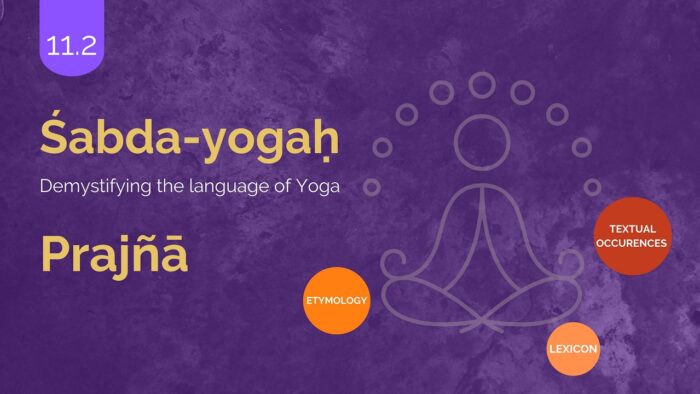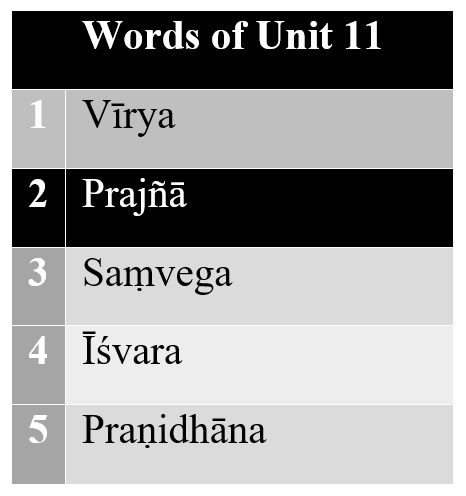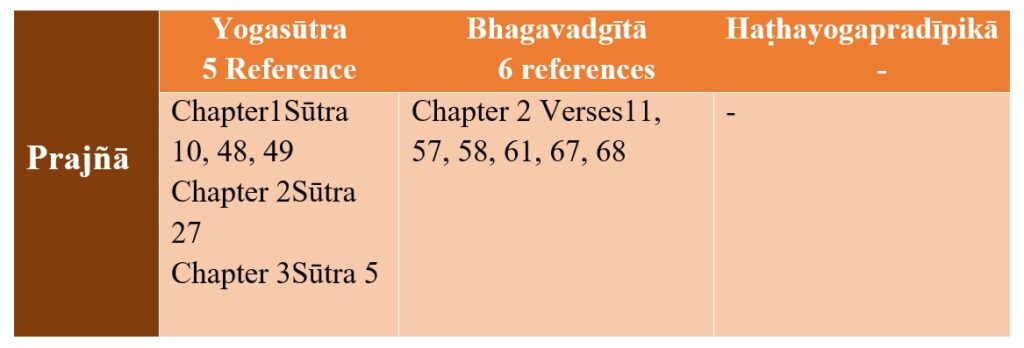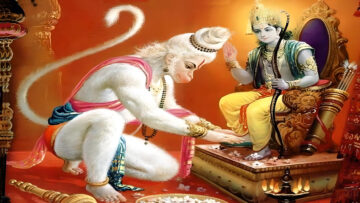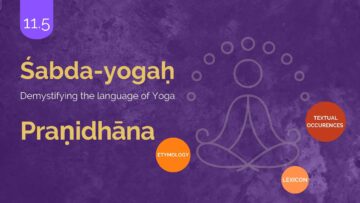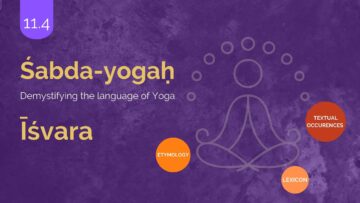Introduction
In this series, Yogic terminologies will be taken up and their –
- Etymological analysis,
- Lexical descriptions and
- Textual occurrences in Yogic literature and their commentaries, as available, will be presented. And finally observations will be made on the references.
Three texts – Yogasūtra, Haṭha-yoga-pradīpikā and Bhagavad-gītā are consulted for textual occurrences portion.
Śabda-yoga is intended to help students, teachers, and professionals of Yoga to develop a sound grammatical, contextual, and thereby an authentic and immersive understanding of Yoga terminologies.
List of Words
We will take up important Yogic terms from Sūtra-s 1. 20 – 23. The terms that will be analyzed in this Unit are –
11.2 Prajñā
Etymology
प्र + ज्ञा + कः +टाप्
pra + jñā + kaḥ + ṭāp
This word is made up of four components
- Pra is the prefix – which means प्रकर्ष – clearly/explicitly[1]
- Jñā is the root that means avabodhana – to know
- Ka is the suffix – it is added by the grammatical rule आतश्चोपसर्गे (aṣṭādhyāyī 3.1.136). The suffix is added to indicate the meaning the doer. Over this the suffix ṭāp is added to bring in the feminine gender. It is added by the rule अजाद्यतष्टाप् (aṣṭādhyāyī 4.1.4)
The derivate statement based on the above etymology is प्रजानातीतिप्रज्ञाprajānātītiprajñā- that which knows (the doer of knowing)
Lexicon
There are two references in the Amarakoṣato this word.
बुद्धिर्मनीषाधिषणाधीःप्रज्ञाशेमुषीमतिः1.5.1.1.5
buddhirmanīṣādhiṣaṇādhīḥprajñāśemuṣīmatiḥ
Buddhi, manīṣā, dhiṣaṇā, dhīprajñā, śemuṣī and mati are the synonyms for intellect
…प्रज्ञाप्राज्ञातुधीमती–2.6.12
prajñāprājñātudhīmatī
prajñāprājñādhīmatī – indicate a lady who is intelligent
Textual Occurrences
Yogasūtra
There are five references to this term in this text. A brief chapter wise discussion is as follows –
Pāda 1
श्रद्धावीर्यस्मृतिसमाधिप्रज्ञापूर्वकइतरेषाम्॥१.२०॥
śraddhāvīryasmṛtisamādhiprajñāpūrvakaitareṣām.. 1.20 ..
prajñā is stated as one of the Upāyas or tools for attaining the state of samprajñātaSamādhi.
- Vyāsa the primary commentator, Bhoja state -prajñāas viveka: – the ability to discriminate between Prakṛti and Puruṣa.
- Maṇiprabhā and Sūtrārthabodhinī take Prajñā to be प्रज्ञापुरुषगोचरख्यात्यभ्यासःprajñāPuruṣagocarakhyātyabhyāsaḥ – the knowledge that resembles the realization about the Puruṣa –consciousness
- Sadāśivabrahmendra takes this Prajñā as the Ṛtambharāprajñā (this is discussed in the next reference).
From all the above descriptions of Prajñā it becomes clear that – it is state of clear understanding/though not realization of the consciousness with a preceding discriminatory knowledge (of Prakṛtiand Puruṣa)
ऋतम्भरातत्रप्रज्ञा॥१.४८॥
ṛtambharātatraprajñā.. 1.48 ..
After attaining excellence in the state of NirvicaraSamādhi – ṛtaṃbharāprajñā manifests.
Nāgojībhaṭṭavṛtti states Prajñā in this context as Sākṣātkāra – direct realization and Vyāsa clarifies the meaning of the term ṛtaṃbharā where he states – that it is a state of mind where there is not even an iota of wrong knowledge (तत्रविपर्यासगन्धोऽपिनास्तिtatraviparyāsagandho’pināsti). The pure knowledge of the Puruṣa is realized in that state.
श्रुतानुमानप्रज्ञाभ्यामन्यविषयाविशेषार्थत्वात्॥१.४९॥
śrutānumānaprajñābhyāmanyaviṣayāviśeṣārthatvāt
This Sūtra is a continuation of idea of the previous Sūtra. Here it is clarified that – Ṛtambharā state that was described earlier is different from the state of knowledge (about the consciousness) arising out of authentic verbal testimony and inference. Though verbal testimony and inference may be able to describe the object clearly – its direct perception alone makes all the special features of the object being perceived more explicit. Hence, here the word Prajñā that is used in connection with the verbal testimony and inference – is to be taken as clear understanding and it is not as sākṣātkāra – realization.
Pāda 2
तस्यसप्तधाप्रान्तभूमिःप्रज्ञा॥2.२७॥‘
tasyasaptadhāprāntabhūmiḥprajñā
In Sūtra 26 Vivekakhyāti is stated as Hānopāya – the means to reach the state of freedom from suffering. Vivekakhyāti is – very clear discriminatory knowledge (of Puruṣa and Prakṛti). This Sūtra states that the person who is endowed with the Vivekakhyāti attains realization (prajñā) in seven states. Prajñā in this Sūtra is described by Nagoji Bhatta as – योगजसाक्षात्काररूपिणी – yogajasākṣātkārarūpiṇī – a state of direct perception arising out of Yoga. This definition is not contradicted by any other commentator.
Pāda 3
तज्जयात्प्रज्ञालोकः॥3.५॥
tajjayātprajñālokaḥ.. 3.5 ..
The preceding Sūtra to this one – states that Dhāraṇā, Dhyāna and Samādhi are called as Samyama. Tajjaya – means ‘on conquering that/ or on attaining great command over the practice of Dhāraṇā, Dhyāna and Samādhi. Prajñāloka – the light of Prajñā manifestes.
The principal commentator, Sage Vyāsa, qualifies this Prajñā as Samādhi-prajñā – a Prajñā – clear knowledge – that arises out of Samādhi. This prajñā is equated to ṚtambharāPrajñā (1.48) by Sadāśivabrahmendra – which does not have any contrary views from other commentators.
Thus these five references on Prajñā throws light on various dimensions of Prajñā in the context of Yogasūtra.
Bhagavad-gītā
There are six references to Prajñā in this text. It is interesting to note that all the six are from the second chapter of the text. And further five of the six references excluding the first reference, are connected to the discussion on the state of Sthitaprajñā. Hence the first reference is discussed separately and all the five references of the Sthitaprajñā state are discussed together. (Only the relevant portion of the verses of Gītā are given)
1) Prajñāvada
अशोच्यानन्वशोचस्त्वंप्रज्ञावादांश्चभाषसे ।2.११॥
aśocyānanvaśocastvaṃprajñāvādāṃścabhāṣase. 2.11 ..
Arjuna is being castigated by Lord Kṛṣṇa. The following words of commentary from ĀcāryaŚaṅkara’s commentary clarifies the meaning of the term Prajñāvada- त्वंप्रज्ञावादान्प्रज्ञावतांबुद्धिमतांवादांश्चवचनानिचभाषसे –
tvaṃprajñāvādānprajñāvatāṃbuddhimatāṃvādāṃścavacanāni ca bhāṣase
(Oh Arjuna!) – you utter the words (vāda) of intelligent people (Prajñāvatāṃ). As implied by this – Arjuna speaks as if he is intelligent and his actions speak in the other manner. Here, then, Prajñā refers to intelligence.
2) Sthitaprajñā
यःसर्वत्रानभिस्नेहस्तत्तत्प्राप्य…तस्यप्रज्ञाप्रतिष्ठिता॥२.५७॥
yaḥsarvatrānabhisnehastattatprāpya …tasyaprajñāpratiṣṭhitā .. 2.57 ..
यदासंहरतेचायं…प्रज्ञाप्रतिष्ठिता॥२.५८॥
yadāsaṃharatecāyaṃ …prajñāpratiṣṭhitā .. 2.58 ..
वशेहियस्येन्द्रियाणितस्यप्रज्ञाप्रतिष्ठिता॥२.६१॥
vaśe hi yasyendriyāṇitasyaprajñāpratiṣṭhitā .. 2.61 ..
इन्द्रियाणांहिचरतां…तदस्यहरतिप्रज्ञांवायुर्नावमिवाम्भसि॥२.६७॥
indriyāṇāṃ hi caratāṃ …tadasyaharatiprajñāṃvāyurnāvamivāmbhasi .. 2.67 ..
…निगृहीतानिसर्वशः इन्द्रियाणीन्द्रियार्थेभ्यस्तस्यप्रज्ञाप्रतिष्ठिता॥२.६८॥
…nigṛhītānisarvaśaḥindriyāṇīndriyārthebhyastasyaprajñāpratiṣṭhitā .. 2.68..
In verse 2.54 Arjun asks Lord Kṛṣṇa about attaining the state of Sthita-prajñā (a steady state of intelligence/knowledge). The response that by Lord Krshna repeatedly contains the usage of the word Prajñā. The refrain “tasyaprajñāpratiṣṭhitā” – his intellect is established – is found in four verses except 2.67.
As could be observed from the verses – a firm unwavering mind is what described as sthita-prajñā.
2.57 – states that a person who is neither overjoyed due to attainment of desired or becomes filled with hatred on failing to attain the desired – attains steady mind.
2.58 – states that a person who withdraws his senses from their respective objects just like a tortoise withdrawing its limbs into the shell – will attain steady mind. 2.61 and 68 reiterate the same idea – as that of the control/mastery over the senses.
Verse 2.67 also indicates that the mind that follows the senses that wander loses its clarity and steadiness. In essence this verse also points to the need of control of the senses to attain a firm state of intelligence.
Haṭhayogapradīpikā – There are no references to the Prajñā in this text.
Tabulation of Textual References 11.2
1) It could be observed from the etymology and grammatical derivation that – Prajñā can both mean – clear knowledge and person who is intelligent. But as could be seen from the Yogic textual occurrences – it is used in the sense of clear knowledge.
2) The meaning of Prajñā in the Yogasūtras – has various shades. In the order of greatness of meaning its meaning are as follows –
- a) Realization (of the consciousness/Puruṣa) – this termed as Ṛtambharāprajñā and also dharmamegha state.
- b) Clear knowledge (of Puruṣa/consciousness) emerging from the practice of Yoga– comparable to realization – culminating in Vivekakhyāti (discrimination between Prakriti and Puruṣa). This knowledge has seven levels.
- c) Authentic clear knowledge (emerging from inference and verbal testimony)
3) A unique expression – Prajñāvada – intellectualism – could be noted in the Gītā.
4) Stability of clear knowledge (Prajñā) is marred by mind that is led by the distracted senses and stability of intellectual clarity is achieved by withdrawal of the senses from their respective objects.
5). The very absence of discussion on Prajñā indicates the emphasis that Hathayoga literature lays on practice – centered on Asana, pranayama and Mudras. The fourth chapter of Hathayogapradeepika – that presents meditative practices like Nadanusandhana also is focused on the absorption or dissolution of the mind – rather than clarity or realization through the mind – that is conveyed through the term Prajñā in other Yogic texts.
Thus it could be noted that the term Prajñā has range of meanings and context consciousness is needed in interpreting the term. By the cross-sectional study of Yoga texts ways and means to have stability in the intellectual clarity also has emerged – which underlines the utility of Śabda-yoga methodology.
[1]Avyayakosha: https://archive.org/details/avyaya-kosa-srivatsankacharya/page/258/mode/2up?view=theater
Unit 11 To be Continued…
Links for previous posts in this unit
Disclaimer: The opinions expressed in this article belong to the author. Indic Today is neither responsible nor liable for the accuracy, completeness, suitability, or validity of any information in the article.

